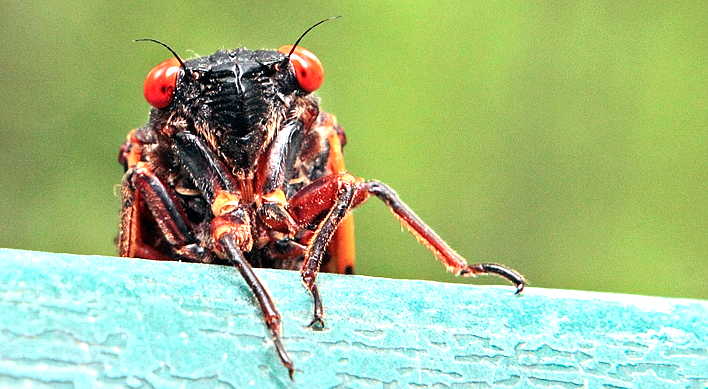 Facebook
Facebook
 X
X
 Instagram
Instagram
 TikTok
TikTok
 Youtube
Youtube

July Is San Diego’s Driest Month, according to precipitation data compiled since the year 1850. Only four hundredths of an inch of rain falls on average this month, compared to almost two inches in January — the wettest month. July also marks the beginning of a new rainfall year, as defined by local meteorological convention.
Native Lilies, such as the Humboldt lily, are blooming this month in widely scattered locations throughout San Diego County’s higher mountains. To find them take a walk on the Noble Canyon Trail in the Laguna Mountains, or explore the pine woodlands of Palomar Mountain and Cuyamaca Rancho state parks. The large, nodding flowers of the lilies — orange or yellow with brown spots — grow in clusters on stems two to eight feet tall.

Cicadas, the insects that sound like tinny buzzsaws in the brush, have been putting up a racket around San Diego lately. Occasionally mistaken for the tail buzz of a rattlesnake, the sound is merely that of a male calling to potential mates. Some 30 species of cicadas inhabit San Diego County, but none are of the famous periodical type that emerge en masse every 13 or 17 years to serenade parts of the eastern United States.
With the advance of summer, the Sagittarius Teapot, in the south-southeast lower left of Scorpius after dark, is starting to tilt and pour from its spout to the right. The Teapot will tilt farther and farther for the rest of the summer — or for much of the night if you stay out late.
In late twilight, Spica shines three or four finger-widths lower left of the first-quarter Moon (it’s exactly first-quarter at 3:11 am Saturday the 17th). High above them is brighter Arcturus, tinted with a lower color temperature: yellow-orange.
The tail of Scorpius is low due south right after dark, to the lower right of the Sagittarius Teapot. How low depends on how far north or south you live: the farther south, the higher. Look for the two stars especially close together in the tail. These are Lambda and fainter Upsilon Scorpii, known as the Cat’s Eyes. They’re canted at an angle; the cat is tilting his head a little to the right and winking (Upsilon is fainter than Lambda; they’re magnitudes 1.6 and 2.6). Both are blue-white supergiants, 700 and 500 light years away, respectively. Yes, the nearer of the two is the fainter one.
The above comes from the Outdoors listings in the Reader compiled by Jerry Schad, author of Afoot & Afield in San Diego County. Schad died in 2011. Planet information from SkyandTelescope.org.


July Is San Diego’s Driest Month, according to precipitation data compiled since the year 1850. Only four hundredths of an inch of rain falls on average this month, compared to almost two inches in January — the wettest month. July also marks the beginning of a new rainfall year, as defined by local meteorological convention.
Native Lilies, such as the Humboldt lily, are blooming this month in widely scattered locations throughout San Diego County’s higher mountains. To find them take a walk on the Noble Canyon Trail in the Laguna Mountains, or explore the pine woodlands of Palomar Mountain and Cuyamaca Rancho state parks. The large, nodding flowers of the lilies — orange or yellow with brown spots — grow in clusters on stems two to eight feet tall.

Cicadas, the insects that sound like tinny buzzsaws in the brush, have been putting up a racket around San Diego lately. Occasionally mistaken for the tail buzz of a rattlesnake, the sound is merely that of a male calling to potential mates. Some 30 species of cicadas inhabit San Diego County, but none are of the famous periodical type that emerge en masse every 13 or 17 years to serenade parts of the eastern United States.
With the advance of summer, the Sagittarius Teapot, in the south-southeast lower left of Scorpius after dark, is starting to tilt and pour from its spout to the right. The Teapot will tilt farther and farther for the rest of the summer — or for much of the night if you stay out late.
In late twilight, Spica shines three or four finger-widths lower left of the first-quarter Moon (it’s exactly first-quarter at 3:11 am Saturday the 17th). High above them is brighter Arcturus, tinted with a lower color temperature: yellow-orange.
The tail of Scorpius is low due south right after dark, to the lower right of the Sagittarius Teapot. How low depends on how far north or south you live: the farther south, the higher. Look for the two stars especially close together in the tail. These are Lambda and fainter Upsilon Scorpii, known as the Cat’s Eyes. They’re canted at an angle; the cat is tilting his head a little to the right and winking (Upsilon is fainter than Lambda; they’re magnitudes 1.6 and 2.6). Both are blue-white supergiants, 700 and 500 light years away, respectively. Yes, the nearer of the two is the fainter one.
The above comes from the Outdoors listings in the Reader compiled by Jerry Schad, author of Afoot & Afield in San Diego County. Schad died in 2011. Planet information from SkyandTelescope.org.
Comments